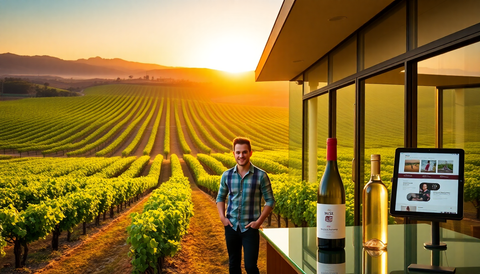In the ever evolving world of wine, there is one style that has captured the hearts and palates of oenophiles worldwide; rosé. Once relegated to the sidelines as a mere summer indulgence, this versatile and captivating wine has emerged as a year-round favourite, commanding respect and attention from even the most discerning wine enthusiasts.
But the story of rosé is far more complex and intriguing than its recent surge in popularity might suggest. Its origins can be traced back centuries, weaving a tapestry of history, tradition, and a relentless pursuit of perfection. As we delve into the rich heritage of rosé, we uncover a tale that transcends the boundaries of mere fashion and reveals the true depth and nuance of this remarkable wine.
The Roots of Rosé
The origins of rosé can be traced back to the ancient winemaking practices of the Mediterranean region, where the production of pink-hued wines has been a part of the cultural fabric for millennia. In the sun-drenched vineyards of Provence, France, for example, the tradition of crafting rosé can be dated back to the 6th century BC, when the Greeks first established their colonies in the area.
These early rosé wines were often produced using a technique known as "saignée," which involves bleeding off a portion of the juice from red wine fermentations. This method not only imparts the desired pink hue but also helps to concentrate the flavours and tannins in the remaining red wine. Over time, winemakers in Provence and other Mediterranean regions refined this process, experimenting with grape varieties, fermentation techniques, and aging methods to create a diverse array of rosé styles.
As the centuries passed, rosé's popularity ebbed and flowed, reflecting the changing tastes and preferences of wine drinkers. In the 20th century, however, a renewed appreciation for the elegance and versatility of rosé began to emerge, particularly in the 1970s and 1980s when a new generation of wine enthusiasts rediscovered the joys of this refreshing and food-friendly style.
The Rise of Rosé
The modern rosé renaissance can be largely attributed to the efforts of winemakers in Provence, who have been instrumental in elevating the perception and quality of this wine. By focusing on meticulous grape selection, gentle pressing techniques, and careful vinification, Provençal producers have consistently crafted rosés that capture the essence of their terroir - the unique combination of soil, climate, and winemaking traditions that impart a distinct character to the wine.
One of the key factors in the success of Provençal rosé has been the region's commitment to using traditional grape varieties, such as Grenache, Cinsault, Syrah, and Mourvèdre. These grapes, which are well-suited to the Mediterranean climate, lend themselves beautifully to the production of rosé, imparting vibrant fruit flavours, refreshing acidity, and a delicate, pale-pink hue.
Moreover, the winemakers of Provence have embraced the versatility of rosé, recognising its ability to pair seamlessly with a wide range of cuisines, from light salads and seafood to grilled meats and spicy dishes. This versatility, combined with the wine's inherent refreshment factor, has made rosé a year-round favourite among wine drinkers, transcending its former status as a mere summer indulgence.
The Global Embrace of Rosé
As the reputation of Provençal rosé has grown, winemakers around the world have been inspired to explore the potential of this captivating style. From California to New Zealand, from Spain to Italy, producers have been experimenting with their own interpretations of rosé, drawing inspiration from the traditions of the Mediterranean while infusing their creations with the unique characteristics of their local terroirs.
This global embrace of rosé has led to a remarkable diversity of styles, each with its own distinct personality. Some producers have focused on crafting bold, fruit-forward rosés, while others have sought to capture the delicate, mineral-driven elegance of their Provençal counterparts. And as the demand for rosé has continued to grow, innovative winemakers have pushed the boundaries, exploring new grape varieties, production methods, and aging techniques to create truly unique and compelling expressions of this versatile wine.
The Future of Rosé
As we look to the future of rosé, it's clear that this wine has firmly established itself as a year round staple, no longer relegated to the summer months. The continued refinement of winemaking techniques, the exploration of new grape varieties, and the growing appreciation for the nuances and complexities of rosé have all contributed to its enduring popularity.
Moreover, the rise of rosé has coincided with a broader shift in consumer preferences, as wine drinkers increasingly seek out lighter, more refreshing styles that can be enjoyed in a variety of settings. This trend has not only benefited rosé but has also inspired winemakers to experiment with other styles, such as sparkling rosé and even rosé-based cocktails, further expanding the versatility and appeal of this captivating wine.
As we delve deeper into the origins and evolution of rosé, it becomes evident that this wine is more than just a passing fad. It is a testament to the enduring power of tradition, the pursuit of excellence, and the human desire to create something truly special. From the sun-drenched vineyards of Provence to the far flung corners of the wine world, the story of rosé is one of resilience, innovation, and a relentless quest for perfection - a story that continues to unfold, captivating wine lovers and connoisseurs alike.
The Enduring Appeal of Rosé
In the ever changing landscape of the wine industry, rosé has emerged as a true standout, a wine that has captured the hearts and palates of consumers worldwide. Its enduring appeal can be attributed to a combination of factors, each contributing to its enduring popularity.
One of the primary drivers of rosé's success is its inherent versatility. Unlike many other wine styles, rosé can be enjoyed in a wide range of settings, from casual backyard gatherings to formal dinner parties. Its refreshing acidity, vibrant fruit flavours, and delicate hue make it an ideal companion for a diverse array of cuisines, from light salads and seafood to grilled meats and spicy dishes.
Moreover, rosé's versatility extends beyond the culinary realm, as it has also become a popular choice for social occasions and celebrations. Its refreshing and approachable nature has made it a favourite among wine drinkers of all ages and backgrounds, contributing to its widespread appeal and growing popularity.
Another key factor in the enduring success of rosé is the ongoing refinement and innovation in winemaking techniques. As producers around the world continue to experiment with grape varieties, fermentation methods, and aging processes, the quality and diversity of rosé styles have continued to evolve, offering wine enthusiasts an ever-expanding array of options to explore and discover.
From the elegant, mineral-driven rosés of Provence to the bold, fruit-forward expressions of California, the global embrace of rosé has led to a remarkable diversity of styles, each with its own unique personality and appeal. This diversity, in turn, has helped to broaden the appeal of rosé, attracting a wider audience of wine drinkers who are eager to explore the nuances and complexities of this captivating wine.
Finally, the rise of rosé has coincided with a broader shift in consumer preferences, as wine drinkers increasingly seek out lighter, more refreshing styles that can be enjoyed year-round. This trend has not only benefited rosé but has also inspired winemakers to explore other innovative styles, such as sparkling rosé and rosé-based cocktails, further expanding the versatility and appeal of this remarkable wine.
As we look to the future, it's clear that rosé's enduring appeal is not a passing fad, but rather a testament to the enduring power of tradition, the pursuit of excellence, and the human desire to create something truly special. From the sun-drenched vineyards of Provence to the far-flung corners of the wine world, the story of rosé continues to unfold, captivating wine lovers and connoisseurs alike with its timeless charm and unparalleled versatility.
Conclusion
The story of rosé is one of resilience, innovation, and a relentless quest for perfection. From its ancient roots in the Mediterranean to its modern day global embrace, this captivating wine has evolved and transformed, capturing the hearts and palates of wine enthusiasts worldwide.
The rise of rosé can be attributed to a combination of factors, including its inherent versatility, the ongoing refinement of winemaking techniques, and the broader shift in consumer preferences towards lighter, more refreshing styles. As producers around the world continue to explore the potential of this remarkable wine, the future of rosé looks brighter than ever, with a seemingly endless array of styles and expressions to discover and enjoy.
Whether you're a seasoned rosé aficionado or a newcomer to the world of wine, the story of this captivating beverage is one that is worth exploring. From the sun drenched vineyards of Provence to the far-flung corners of the globe, the origins and evolution of rosé offer a rich and fascinating tapestry of history, tradition, and a relentless pursuit of perfection. So raise a glass to the enduring appeal of rosé, and let its timeless charm and unparalleled versatility transport you on a journey of discovery and delight.




Comments (0)
There are no comments for this article. Be the first one to leave a message!